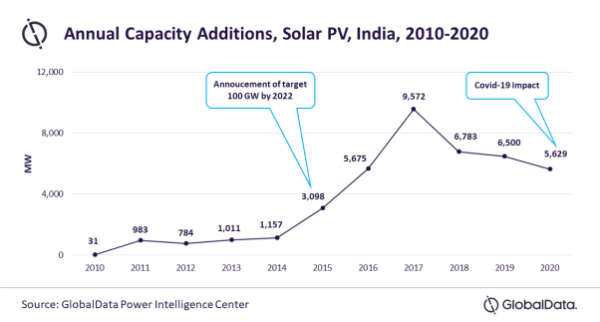The additional allocation of $2.6 billion to the production linked incentive (PLI) scheme will play an important role in shaping up the domestic solar manufacturing industry and putting the sector on the path to achieve the 2030 target of installed PV generation capacity, says a new report by data and analytics company GlobalData.
India targets to achieve 500 GW of installed renewable energy capacity by 2030 before reaching zero carbon emissions by 2070. This includes 280 GW from solar PV. The Union Budget 2022-23 allocates an additional $2.6 billion to the PLI scheme for solar to promote and push domestic PV module manufacturing.
Mohit Prasad, Practice Head of Power at GlobalData, comments: “India is the third biggest emitter of greenhouse gases after China and the US. To reduce this, India has been pushing for renewable energy development, especially the solar sector. In line with this, India’s solar sector is heavily dependent on the imports of solar equipment. The Covid-19 pandemic disrupted the supply chain as solar equipment could not be imported, thereby affecting the solar PV capacity additions.
The imports of components used in the solar industry increased substantially since the target under the National Solar Mission was revised to 100 GW of solar PV by 2022. The Jawaharlal Nehru National Solar Mission (JNNSM), or the National Solar Mission, was launched in 2010 to achieve 20 GW of installed solar capacity by the year 2022. The target has since then been revised twice and now boasts the 100 GW target.
Prasad continues: “According to GlobalData, India witnessed a sudden spurt in its annual solar PV installations in 2015 when 3 GW of new solar installations were added to the grid, which used to be around 1 GW in previous years. However, the subsequent two years witnessed new highs in the annual installations, which were driven primarily by solar components’ imports from countries like China, Malaysia, etc at a lower cost. This caused many domestic producers to stop their production, resulting in heavy losses thereby crippling the domestic industry.”

In April last year, the Government of India introduced the PLI scheme for solar components. The scheme, with an outlay of $603 million initially, offers funding support to bidders who commit to setting up fabs to produce everything from polysilicon to PV modules in India. The effect of PLI is evident from more than 11 GW of capacity addition by the nation from January-November 2021.
Prasad concludes: “As India has set a net-zero climate target by 2070, investment in renewable energy is required. This can be addressed if there are policies to promote investments in the sector. With a target of 280 GW for solar PV by 2030, India not only should rely on imports but must also promote the domestic manufacturing sector.
This content is protected by copyright and may not be reused. If you want to cooperate with us and would like to reuse some of our content, please contact: editors@pv-magazine.com.









By submitting this form you agree to pv magazine using your data for the purposes of publishing your comment.
Your personal data will only be disclosed or otherwise transmitted to third parties for the purposes of spam filtering or if this is necessary for technical maintenance of the website. Any other transfer to third parties will not take place unless this is justified on the basis of applicable data protection regulations or if pv magazine is legally obliged to do so.
You may revoke this consent at any time with effect for the future, in which case your personal data will be deleted immediately. Otherwise, your data will be deleted if pv magazine has processed your request or the purpose of data storage is fulfilled.
Further information on data privacy can be found in our Data Protection Policy.